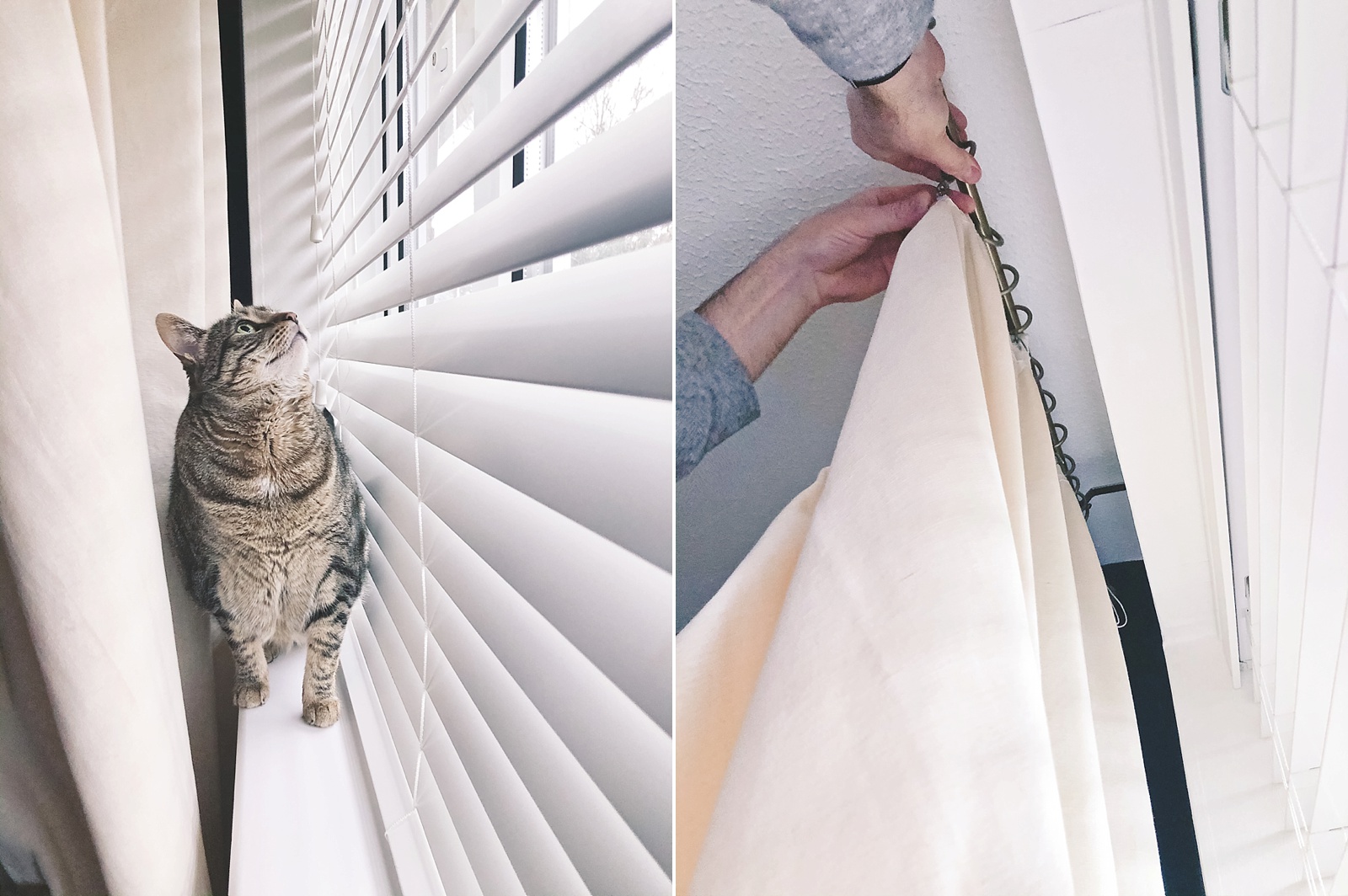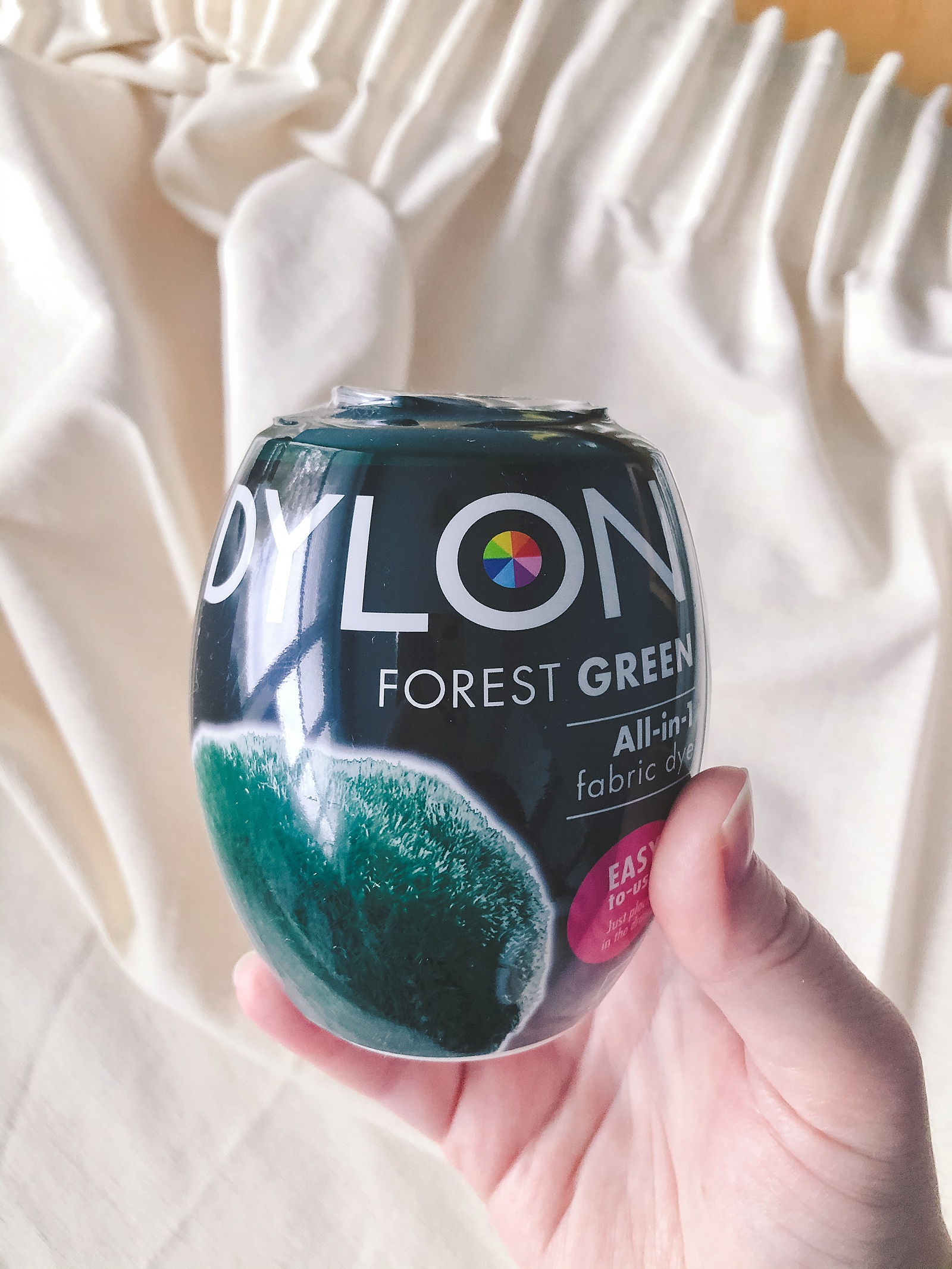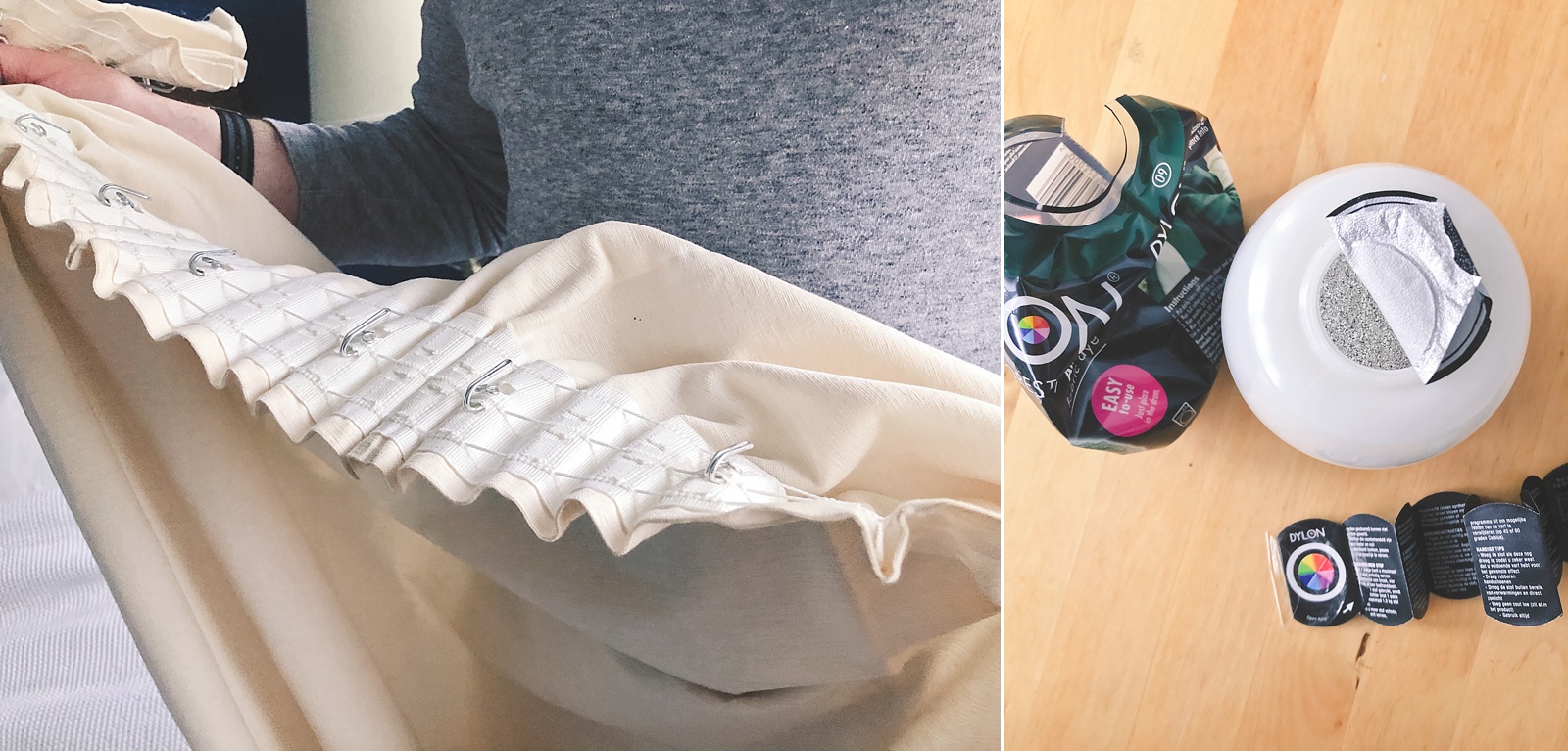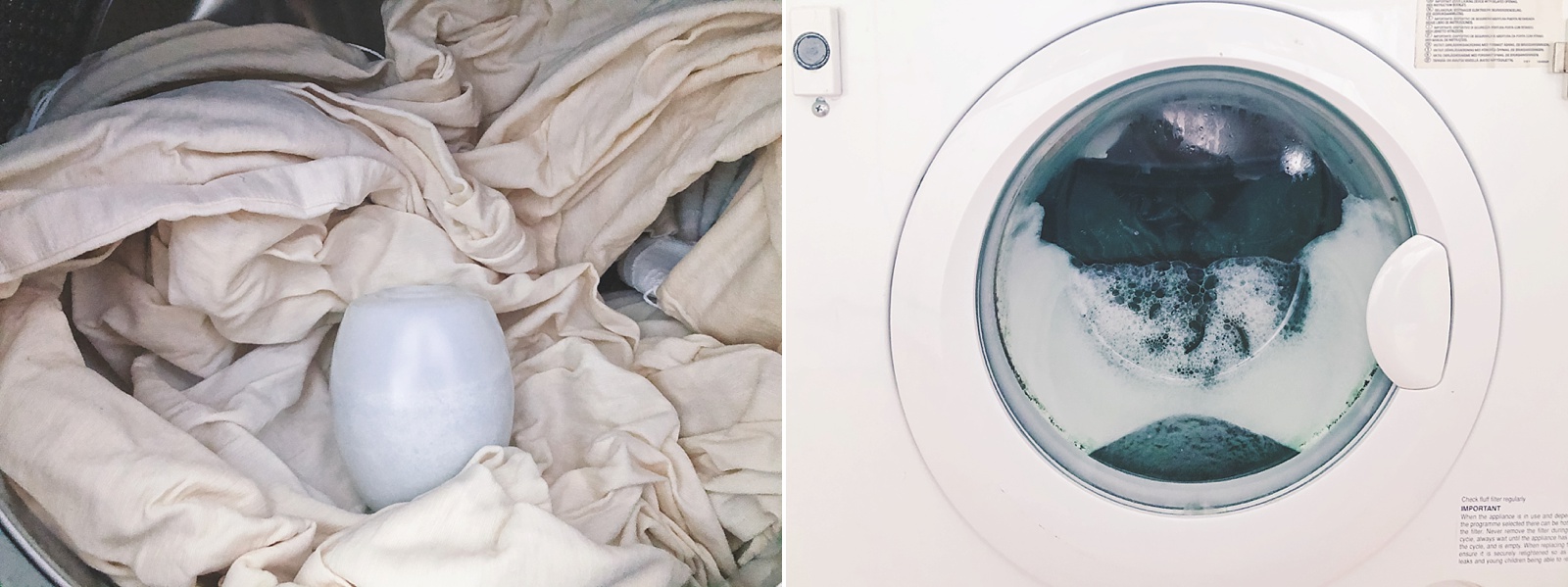
Mr. B and I have this joke that I bursted onto the scene and brought color to his life. Quite literally, too. He has owned a flat that he's lived in for 15 years, and while beautifully neutral in a clean contemporary palette, it felt more like a house than a home. Within 20 minutes of walking through the door, I raised one kitchen cabinet shelf to optimize space for an olive oil bottle, and you would have thought I won the Nobel with his enthusiastic reaction. More ideas kept spilling out, and soon the bedroom had a feature wall of dark navy blue, the living room started acquiring textured pillows and coasters, and the kitchen got its own modern transformation to the tune of white cabinets.
The ivory curtains were forgettable though. You didn't notice them much except if you're a light-affected sleeper like me and recall its lack of blackout capabilities every morning. Until Mr. B casually mentioned washing the guest room's curtains. After that, all I could see were the age-worn, some water spots, and the paleness of our own bedroom curtains. Well, faithful curtains of over a decade, tough love moment because you need a makeover, and I just found out you were 100% cotton.


I have dyed fabric before in the States using a giant stainless steel kitchen sink, but there was no way I could do the same with large curtains in the smaller British apartment sink. Knowing how resourceful and more environmentally-driven the Brits are, there had to be a way to upcycle curtains into a new shade without buying a new set. Thank goodness for Google because I found the solution, and it is gloriously easy.
No big metal sinks needed when you have a washing machine to do the dirty work for you! For a mere £10 and 6 wash cycles, our bedroom was about to get ultra cozy.
Important Note: I used Dylon's Forest Green color dye formulated for use in the washing machine. This dye is meant for cotton, linen, or other all-natural fabrics. If your fabric is a mix of synthetic and natural, then it'll likely dye to lighter shades. For curtains that are 100% synthetic like polyester or have a flame-retardant finish, the dye will not work. On our curtains, you will see the top back fabric strip designed to hold the the curtain rod clips and the curtain seams are still pure white after dyeing. It's the perfect visual example of what happens when dyeing the entire curtain with various natural and synthetic components!
How to Dye Curtains in the Washing Machine
[See specific fabric dye's instructions to determine how many pods you need for your project. For our two curtain panels, I used 1 pod for each panel (2 pods in total). For a super rich, darker hue of your chosen color, use 2 pods for each (4 in total). British washing machines vary greatly in design, so please also read your operating manual to determine which cycle setting is best for this project.]PROJECT MATERIALS•
Washing machine• Natural fiber curtains (e.g., cotton, linen)
INSTRUCTIONS
1. Remove any curtain hooks you might have. Wash one of your curtain panels with laundry detergent in your washing machine. To prep for dyeing, your fabric must be damp, so you might as well give it a good wash especially if they haven't been washed in a long while.
2. Remove the color dye pod's plastic sleeve and inner foil lid. After the initial wash, place the open color dye pod on top of your wet fabric. With the pod ready to dye, you'll need to run a full wash cycle on whichever setting gives you a 30°C (86°F) or 40 (104°F) degrees temperature.
3. Once the cycle completes, run another normal wash cycle with laundry detergent to rid of any excess dye on your curtain. Remove curtain from machine and hang to dry.
4. Repeat Steps 1 through 3 for your second curtain panel.
5. After both curtain panels have been dyed, run an empty cycle on your washing machine to help make sure all dye is removed from the machine before you begin any everyday laundry.
6. Iron out your curtains and then hang up!
Post-Project Notes
One thing we didn't anticipate was the dyed creases caused by the thick stiffness of our curtain fabric in the washing machine. We actually love it more for the organic "tie dyed" texture, but it wasn't planned! If you have more fluid, thinner curtains, then the creases won't happen. Since these are 15 year-old curtains that have been exposed to constant UV light with sun and water spots, we knew if something went wrong in the dyeing process, it wouldn't be a tragedy. However, if you have more sentimental or expensive curtains, it goes without saying to always do a test before dyeing anything.
The Blurb on British Washing Machines
What can be one of the biggest cultural shocks to Americans is that most British washing machines are located in the kitchen and that tumble dryers are elusive. British homes have no other real place to put them due to domicile sizes being typically much smaller compared to an American house. More and more new build or renovated homes in the UK are prioritizing creating a utility room where the washing machine (and the rare drying machine) are now located, but those are still in the minority.
British laundry ways never really distressed me much since I have always air-dried my clothes for environmental and "preserve the fabric" reasons. And good news is that the machines here are much more energy-efficient than those in the States. But, reader, in spite of my penchant for eco, I'll be honest that I really, really miss fluffy bath towels. I have a few American expat friends who have purchased a tumble dryer just to get fluffy towels (and help with their kiddos' endless laundry piles). Mr. B and I don't use fabric softener for various reasons, so the air-dried crunchy towels continue to bring about nostalgia of softer times.
I have also found that since British machines are front-loaders located in the kitchen behind a cabinet door, they get moldy faster around the rubber bits and give off a stale, damp smell after long use. It's hard to practically keep the machine door open to air out when you're needing to do other things in the kitchen. Cleaning the washing machine with an anti-bacterial and limescale removal element (like
Dettol) often becomes habit.
With modern technology evolutions, there are even washer-dryer combination machines which continues to boggle my mind. Water? Electric heat? Together in the same drum? British ingenuity strikes again, but there is a downside for anyone used to conquering laundry in one afternoon however. Because of the country's energy regulation factors, it takes exponentially longer to do laundry. What would normally take 20-40 minutes in an American washing machine could take up to 3 hours in a British one. I learned this in the furnished AirBnb flat I rented in Hove. It had a Hotpoint branded machine (in the kitchen, of course), and the "quick wash" setting was all lies. Why did it take 3 hours to run a standard light load?! I don't know, but it did. I had to reach out to a few UK friends to learn I could get a "shorter" wash cycle at the breakneck speed of an hour and a half.
"Stay Calm, Carry On" will take on a whole new meaning in your British life when it comes to washing clothes, but at least tea is always there for us. And a fruit scone or two.
Some of the above product links are affiliate-linked and purchasing through these links helps support this website at no cost to you! You can find my full affiliate disclosure policy here.













Social Icons